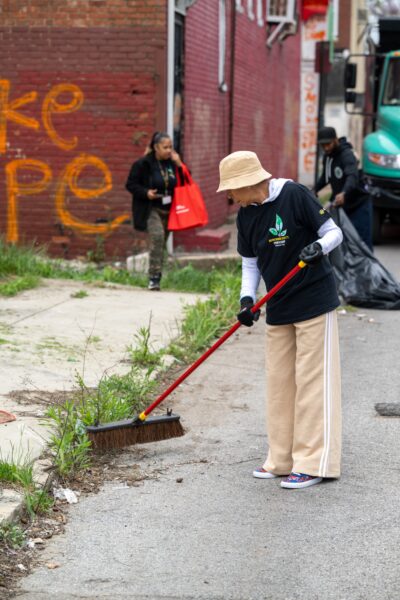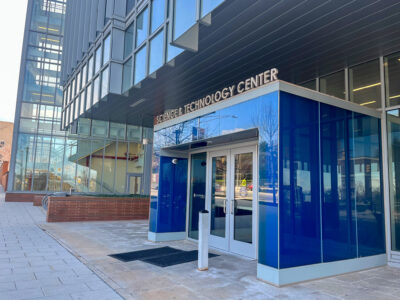We came, we saw, we hacked
The weekend before last, roughly 70 software designers, developers, makers, and educators convened at Digital Harbor High School for an Education Hack Day. The mission was simple: listen to problems sourced by teachers from around the world, pick a dozen or so to tackle, and form teams around those problems that would each come up with and execute a creative solution to solve them.
Ideas were pitched and teams were formed on Saturday morning. Throughout the day, we setup some breakaway workshops that would allow for 1 or 2 members from each team to leave the working team for an hour and quickly learn how to use a software API or how to pitch the judges on Sunday. We kicked everyone out of the school around Midnight on Saturday and reconvened at 8am on Sunday. The mood on game day was a bit more intense. With just hours before a functional demo had to be presented to a panel of judges, you could tell that people were fighting distraction to stay in the zone.
Sunday Presentations
At 4pm on Sunday, presentations began. Judging the presentations was an eclectic but versed group of educators, ed-focused investors, policy makers and more. We were fortunate to have the following judges at our event:
Frank Bonsal, GP at New Markets Venture Partners,
Matt Van Italie, CAO of Baltimore City Schools, formerly with KIPP Schools and also McKinsey,
Brian Eyer, Principal at Digital Harbor High School,
Tom “TK” Kuegler, GP at Wasabi Ventures,
Tom Murdock, Founder at Moodlerooms,
Bill Ferguson, State Senator for Maryland, and
Scott Messinger, City Schools Teacher & Ed Tech Founder.
Each team had to demo something. It didn’t have to be pretty but we wanted to see something demoed and not just a powerpoint of what it might be. Teams were judged on 4 main points:
- Does it work?
- Is it a good idea with a good problem/solution fit?
- Does it show a well-designed experience and execution?
- Holistically, is their a ‘wow factor’?
Our Teams
 Digital Harbor (1st Place)
Digital Harbor (1st Place)
Built by: Andrew Coy, Jonathan Julian, Ronin Wood, and Donald Abrams
Digital Harbor is a safe application that is installed on students’ iPads in lieu of Safari that enables teachers to “push” a list of web urls to all the iPads in a set. The app allows students in the class to browse those sites, but no others.
 Pluck (2nd Place)
Pluck (2nd Place)
Built by: Lokesh Dhakar and Bryan Connor
Pluck lets you choose content from a web page that you want to share, and it hides everything else on the page. In a couple of clicks and the less than ten seconds, you’ll have a plucked version of a page ready to share with friends. All of this happens in the browser, no clunky software to install.
 Pedante (3rd Place)
Pedante (3rd Place)
Built by: Jess Gartner, Karen Shea, Robert Earle, Edmund Kemokai, David Robson, Andy Hlavka, Joe Manko, and Eddie Hermoso
Pedante allows teachers to upload videos of their own teaching, then mark events within the video that illustrate specific classroom skills, such as “positive reinforcement”. Other teachers can search for keywords and view several video clips that show examples of this skill. Pedante helps teachers improve their classroom skills by watching other teachers in action.
 ParentConnect (4th Place)
ParentConnect (4th Place)
Built by: Eliot Pearson, Mark Headd, Heather Mills, and Mike Brenner
ParentConnect takes the pain out of scheduling parent-teacher conferences by allowing a teacher to go online and create an availability schedule, then allowing a parent to confirm their end of the appointment over a toll-free, touch-tone phone. Logo by Andy Mangold!
Sign up for Parent Connect »
 BoardSpeak (5th Place)
BoardSpeak (5th Place)
Built by: Ted O’Meara, Alex MacDonald, and Avery Erwin-McGuire
Boardspeak is an AAC application; it provides image-to-speech for autistic individuals, stroke patients, and other individuals with cognitive disabilities. It is device agnostic to match many different use cases. Boardspeak is also free.
 CheckPlus (6th Place)
CheckPlus (6th Place)
Built by: Andy Mangold, Anthony Mattox, Josh Hepworth, and Kate Bladow
A beautifully designed web app that acts as a bit of a to-do “checklist” for students, keeping track of all sorts of things like assignments, group meetings, money for lunch, etc. It also has a view for teachers that lets them see when students have checked off items related to their classwork.
 Baltimore School Watch
Baltimore School Watch
Built by: Tom Smith, John Baldo, Robert Douglas, Tim Collins, Jon Smalletz, Amy Smith, and Henry van Wagenberg
A dashboard for the city of Baltimore that visually compares all the city schools in one place. It’s a “US News and World Report” ranking system and map that includes publicly available test scores, student ratings, and other vital data.
 What’s Due?
What’s Due?
Built by: Shawn Grimes, Stephanie Grimes, Jackie Parto, and Rahul Khorjekar
“What’s Due?” is an assignment tracker where teachers can enter in assignments and due dates and have reminders emailed to parents or delivered as push messages to a companion student app.
 Toader
Toader
Built by: Todd Blatt, Marty McGuire, and Amy Hurst
Toader was a mix of a hardware and software product. It allows you to customize the traditional Vietnamese frog instruments that let you rub a mallet over the “back of a frog” and create a unique tone. By customizing it, you can specify on a computer how you want the wave on the back to look and produce unique sounds.
 Hey, Teacher
Hey, Teacher
Built by: Jolyon Terwilliger, Yuebo Wang
Hey, Teacher! is a virtual hand-raising app for the classroom designed to ensure no student is left behind. Hey, Teacher! allows students to submit their question for assistance via the App from their desk without interrupting the Teacher and provides the teacher with an up-to-date queue of students who need assistance in the order received. Logo by Rebecca Slogeris.
Some Final Thoughts
The event was an experiment on many different levels. Personally, this was the first time I participated in an event I was organizing. Since it was structured as a competition of sorts, I don’t think it passes the sniff test to participate in a competition that I’ve setup. It also makes it incredibly difficult to manage day-of-event logistics while you’re head-deep in product design.
Another experiment was the intentional exclusion of the “business people” from the product development teams. Instead, we replaced them with teachers. From my research in EdTech, it seems that too many products are being developed by business people and not with the input of the customers, which in this case are the educators. I wanted to try and fix that on a micro level by the replacement. But, if the intent of the event is to potentially start new companies, it’s equally important to include business-minded folks that can help answer questions on market viability, product placement and branding.
There was a common frustration throughout the weekend with the lack of a consistent internet connection. We were fortunate to have BTS donate 3 WiMAX modems to our event to subsidize the school’s wifi that blocks 95% of the internet. Unfortunately, this still wasn’t a sufficient result. My choice of having the event in public high school was because I wanted the teams to be in the environment of an educator, specifically an inner-city public school. I wanted us to feel the constraints they feel, which in this case were the constricted internet and uncomfortable temperature of a seemingly broken climate-control system. Looking back, it’s important to recognize this environmental influence but there are some fundamental necessities, like solid WiFi, that need to be in place for a weekend hackathon.
I was really impressed with the outcome from the weekend. There are a large handful of truly marketable products that were developed and small but passionate community of educators, principals, and investors that are all interested in helping make that happen. I didn’t expect folks to reinvent curriculum this weekend but I wanted to put the right problems and people in the room to show that there’s a viable opportunity to build education technology products here in Baltimore.
Finally, a HUGE Thanks To…
Voxeo Labs (Tropo), New Markets Venture Partners (especially Frank Bonsal III and Elizabeth Chou), Digital Harbor High School (especially Principal Eyer, Andrew Coy, and Nicole DiVito), Media Temple, Pillsbury Law, ImagineK12 Incubator, DonorsChoose.org, Wasabi Ventures (especially Tom Kuegler), PB Works, TestSoup, Ignite Baltimore’s Ignition Grant, Intridea, Kickboard, 4.0 Schools, Edukwest, ETC, GBTC, Campfire Apps, Cloudmine (especially Ilya Braude), Rosenberg Martin, Digital Harbor Foundation, BTS, SAIC, and the countless number of educators that participated online.
Additional recaps of the event:
- Article from Jonathan Julian
- Article from Mark Headd
- Article and Video from Steve Earley
- Photos of the event from Michael Rosner (Gallery 1, Gallery 2)
- Photos of the event from Mark Headd
- Photos of the event from Jess Gartner
Join the conversation!
Find news, events, jobs and people who share your interests on Technical.ly's open community Slack

Baltimore daily roundup: HR's big AI-influenced shift; EDA Tech Hubs lessons; DCHD's $2.25M in grants

Baltimore daily roundup: Bowie State's esports reputation; AI impersonator arrested; EpiWatch names new CEO

Baltimore daily roundup: Real estate deal in the Peninsula; Missing $100M nitrile glove factory; Dirt bike clampdown

